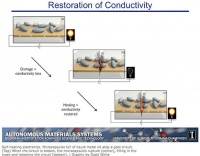Led by aerospace engineering professor Scott White and materials science and engineering professor Nancy Sottos, the researchers published their results in the journal Advanced Materials.
‘It simplifies the system,’ said chemistry professor Jeffrey Moore, a co-author of the paper. ‘Rather than having to build-in redundancies or a sensory diagnostics system, this material is designed to take care of the problem itself.’
According to a statement, electronics manufacturers are putting as much density onto a chip as possible, which can lead to reliability problems, such as failure stemming from fluctuating temperature cycles as the device operates.
A failure at any point in the circuit can shut down the whole device. In applications such as instruments or vehicles for space or military functions, failed electronics cannot be replaced or repaired.
‘In general, there’s not much avenue for manual repair,’ said Sottos. ‘Sometimes you just can’t get to the inside. In a multilayer integrated circuit, there’s no opening it up. Normally, you just replace the whole chip. It’s true for a battery too. You can’t pull a battery apart and try to find the source of the failure.’
The Illinois team previously developed a system for self-healing polymer materials and has adapted its technique for conductive systems.
To do so, it dispersed microcapsules, as small as 10 microns in diameter, on top of a gold line functioning as a circuit. As a crack propagates, the microcapsules break open and release the liquid metal contained inside. The liquid metal fills in the gap in the circuit, restoring electrical flow.
‘What’s really cool about this paper is that it’s the first example of taking the microcapsule-based healing approach and applying it to a new function,’ said White. ‘Everything prior to this has been on structural repair. This is on conductivity restoration. It shows that the concept translates to other things as well.’
A failure interrupts current for microseconds as the liquid metal immediately fills the crack. The researchers demonstrated that 90 per cent of their samples healed up to 99 per cent of original conductivity, even with a small amount of microcapsules.
The self-healing system is also said to have the advantages of being localised and autonomous. Only the microcapsules that a crack intercepts are opened, so repair only takes place at the point of damage. Furthermore, it requires no human intervention or diagnostics.
‘In an aircraft, especially a defence-based aircraft, there are miles and miles of conductive wire,’ Sottos said. ‘You don’t often know where the break occurs. The autonomous part is nice — it knows where it broke, even if we don’t.’






Red Bull makes hydrogen fuel cell play with AVL
Formula 1 is an anachronistic anomaly where its only cutting edge is in engine development. The rules prohibit any real innovation and there would be...